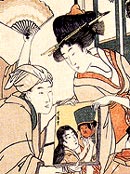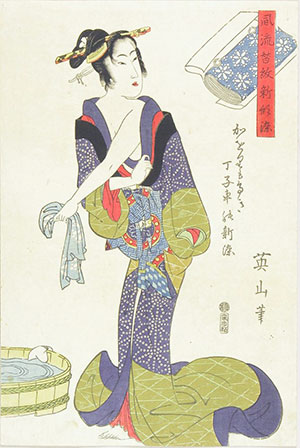

Kikugawa Eizan (菊川英山)
|
 During the first quarter of the nineteenth century, the print artist and painter Kikugawa Eizan (菊川英山 1787-1867) developed a new typology for bijinga (pictures of beautiful women: 美人画). Although some of his early work was dependent (superficially) on the style of his great predecessor Kitagawa Utamaro (1753-1806), to dismiss Eizan as a mere imitator seriously undervalues his achievement. As will be discussed here, each artist had different concerns about how to portray women, and Eizan was one of a younger generation for whom fûryû (fashionable: 風流) took precedence over psychological explorations, one of Utamaro's innovative interests.
During the first quarter of the nineteenth century, the print artist and painter Kikugawa Eizan (菊川英山 1787-1867) developed a new typology for bijinga (pictures of beautiful women: 美人画). Although some of his early work was dependent (superficially) on the style of his great predecessor Kitagawa Utamaro (1753-1806), to dismiss Eizan as a mere imitator seriously undervalues his achievement. As will be discussed here, each artist had different concerns about how to portray women, and Eizan was one of a younger generation for whom fûryû (fashionable: 風流) took precedence over psychological explorations, one of Utamaro's innovative interests.
Nearly all ukiyo-e artists emulated other print designers and painters at the beginning of their careers, and many borrowed details or entire compositions well into their mature working periods. While still only in his early twenties, Eizan assimilated elements of the Utamaro style, but soon afterwards introduced a reimagined vision of the female face and form that was uniquely his own. The print-buying public recognized this, for when Eizan abandoned his youthful forays into portraying kabuki actors and dedicated himself entirely to depicting Edo beauties, success was almost instantaneous, and his fame as a bijinga master reportedly spread beyond the environs of Edo.
A progression toward increased volume and greater reliance on straight contour lines in the faces of bijin, along with corresponding changes in the form of the body, was a consistent feature among the works of the important bijinga artists during Kyôwa-Bunka-Bunsei (1801-30). The brilliantly inventive and influential Kitagawa Utamaro (喜多川歌麿 c. 1753-1806) exemplifies the beginning of this trend, as his female figures began to increase in volume during his final years, 1801-1806.
 Reflecting the popular taste in rendering the women of the "floating world" (ukiyo: 浮世), there was an across-the-board increase in amplitude and volume to be found among the designs of various ukiyo-e artists. Prominent among them was Katsushika Hokusai (葛飾北齋 1760-1849) who adopted diminutive figures for his bijinga c. 1794-1798. A few years later the faces and bodies of Hokusai's bijin were drawn with somewhat greater volume, often with necks formed by straight lines. Then, by the early 1820s, Hokusai introduced faces and bodies that were dramatically more massive. Other artists following this style in bijinga included Utagawa Toyokuni I (歌川豊國 1769-1825), Utagawa Kunisada (歌川國貞 1786-1865), and Keisai Eisen (渓齋英泉 1790-1848).
Reflecting the popular taste in rendering the women of the "floating world" (ukiyo: 浮世), there was an across-the-board increase in amplitude and volume to be found among the designs of various ukiyo-e artists. Prominent among them was Katsushika Hokusai (葛飾北齋 1760-1849) who adopted diminutive figures for his bijinga c. 1794-1798. A few years later the faces and bodies of Hokusai's bijin were drawn with somewhat greater volume, often with necks formed by straight lines. Then, by the early 1820s, Hokusai introduced faces and bodies that were dramatically more massive. Other artists following this style in bijinga included Utagawa Toyokuni I (歌川豊國 1769-1825), Utagawa Kunisada (歌川國貞 1786-1865), and Keisai Eisen (渓齋英泉 1790-1848).
Eizan's approach to physiognomy was consistent, in its evolution, with that of his contemporaries. His treatment of the female face remained fluid and showed slight variations in form and volume within each phase of development. Eizan's earliest style (c. 1806-08) for the female face relied on a pronounced oval with a tapered chin, a long straight nose, and thick arched eyebrows. Around 1808-1813, the face became fuller and slightly less elliptical, with the nose sometimes inclining toward the aquiline and the lower lip occasionally larger than the upper one. One example is shown in the illustration at the top right, a design from the series Goshiki-zome (Five colors of dye: 五色染), published by Izumiya Ichibei (Kansendô) circa 1809-1813. Here a geisha descends some stairs while her female attendant carries a a black case containing a shamisen (三味線, a three-stringed, long-necked instrument) that the geisha will play to entertain her clients. For an earlier work by Eizan from 1807, see Iki (Eizan).
 Next, during the period that many consider Eizan’s finest (1814-1817), the bijin face became thinner, with a delicacy and an indefinable calm that some have nicknamed "doll-face". This style is also conspicuous for its reversal of amplitude, when the physiognomy narrowed slightly rather than widened, at least for a few brief years. However, by around 1818, Eizan substantially increased the volume, depicting women with thicker necks and heavier faces and bodies. For example, in the iamge shown immediately above, we have a design from circa 1814-17, when Eizan produced a series of ôban-format prints titled Fûryû kaemon shingata-zome (New patterns for fashionable dying: 風流替紋新形染), again published by Izumiya Ichibei (Kansendô). A young beauty, dressed in up-to-date and colorful robes, has exposed a shoulder as she goes about washing, certainly a slightly riské subject. Below the title cartouche is an an inscription that reads Kaori mo takaki chôji guruma no shinzome (かおりも高き丁字車の新染).
Next, during the period that many consider Eizan’s finest (1814-1817), the bijin face became thinner, with a delicacy and an indefinable calm that some have nicknamed "doll-face". This style is also conspicuous for its reversal of amplitude, when the physiognomy narrowed slightly rather than widened, at least for a few brief years. However, by around 1818, Eizan substantially increased the volume, depicting women with thicker necks and heavier faces and bodies. For example, in the iamge shown immediately above, we have a design from circa 1814-17, when Eizan produced a series of ôban-format prints titled Fûryû kaemon shingata-zome (New patterns for fashionable dying: 風流替紋新形染), again published by Izumiya Ichibei (Kansendô). A young beauty, dressed in up-to-date and colorful robes, has exposed a shoulder as she goes about washing, certainly a slightly riské subject. Below the title cartouche is an an inscription that reads Kaori mo takaki chôji guruma no shinzome (かおりも高き丁字車の新染).
As with preceding generations of ukiyo-e artists, both Utamaro and Eizan used the term fûryû in the titles of series or single-sheet designs, but with a notable difference in frequency. Utamaro included it in only 13 series for a total of approximately 82 separate sheets, or less than four percent for all formats. In contrast, Eizan used fûryû in the titles of at least 123 series in ôban designs (representing the vast majority of all his print formats) for a total of at least 500 separate sheets or approximately 37 percent of the artist's total recorded ôban sheets.
Late in his printmaking career Eizan's bijinga reflected the popular fashions of the day. Female forms took on greater volume, their faces were wider and more rectilinear, postures were often slightly stooped or bent forward, and robes were often heavily patterned. One example, published by Aritaya Seiemon, possibly from circa 1818-23, portrays a young beauty reading a letter. She appears to have reacted rather emotionally to its contents, as she clenches her teeth on a tissue (a conventional trope for emotion in ukiyo-e prints and paintings). The kakemono-e (掛物絵) format, in this instance, measures 735 x 255 mm, which mimics a hanging scroll.
It appears that sometime in the 1830s Eizan abandoned print design for painting, working in that genre for about three decades. The last recorded work was a painted six-panel folding screen from 1863.
Utamaro's influence on the young Eizan was significant, but it did not prevent Eizan from developing his own distinctive portrayals of women. Both artists worked within a social and artistic milieu celebrating ever-changing fashion and ideals of beauty. The fluctuating concepts of fûryû were essential to the choices and treatments of figures portrayed by all ukiyo-e artists who designed bijinga.
Eizan's oeuvre represents an achievement beyond mere variations of Utamaro's late style. While Utamaro often arranged his compositions for the expression of emotion, Eizan was far more likely to pose his figures for the display of beauty and style. This shift in emphasis was no doubt fueled by the support of a print buying public who responded enthusiastically to the depiction of fûryû as the central theme in bijinga. As individuated portrayal of the feminine emotional state became less of a concern for Eizan than it had been for Utamaro, the focus upon psychological verisimilitude or the physicality of personal feelings was replaced by a focus on the accurate reflection of fashion and play (fûryû and asobi). © 2001-2019 by John FiorilloBIBLIOGRAPHY
- Asano, S., "A brief factual biography of Utamaro and an overview of his artistic achievements," in: The passionate art of Utamaro. London 1996, p. 68.
- Clark, T., "Mitate-e: Some thoughts, and a summary of recent writings," in: Impressions, New York 1997, no. 19, pp. 7-27.
- Fiorillo, J., "Eizan: Putting on a new face---A mirror of fûryû, asobi and ikie," in: Andon 71, Society for Japanese Arts, May 2002, pp. 524.
- Kondo, E., Il mondo di Eizan. Rome 1991.
- Kondo, E., Eizan: Nippon ukiyo‑e hakubutsukan shozô (Eizan: Collection of the Japan Ukiyo‑e Museum, 英山•日本浮世絵博物館所蔵)). Tokyo 1996.
- Konishi, J., "Fûryû: An ideal of Japanese esthetic life," in: M. Schneps and A. Coox (eds.), The Japanese image. Tokyo/Philadelphia 1965, pp. 271-278.
Viewing Japanese Prints |